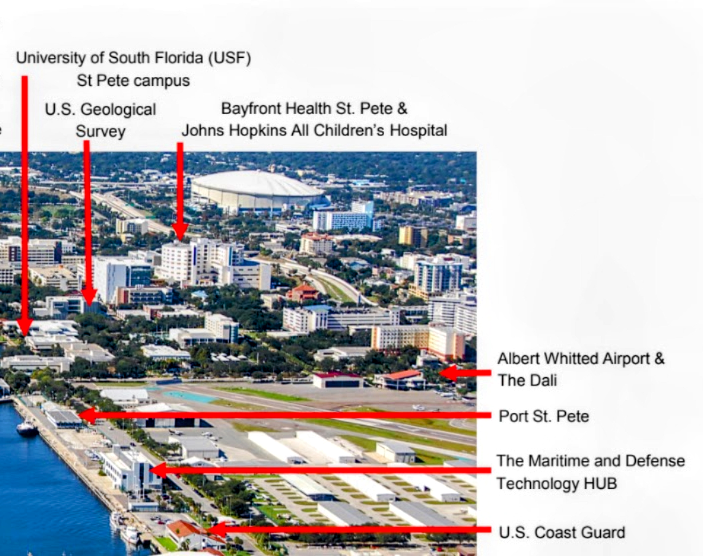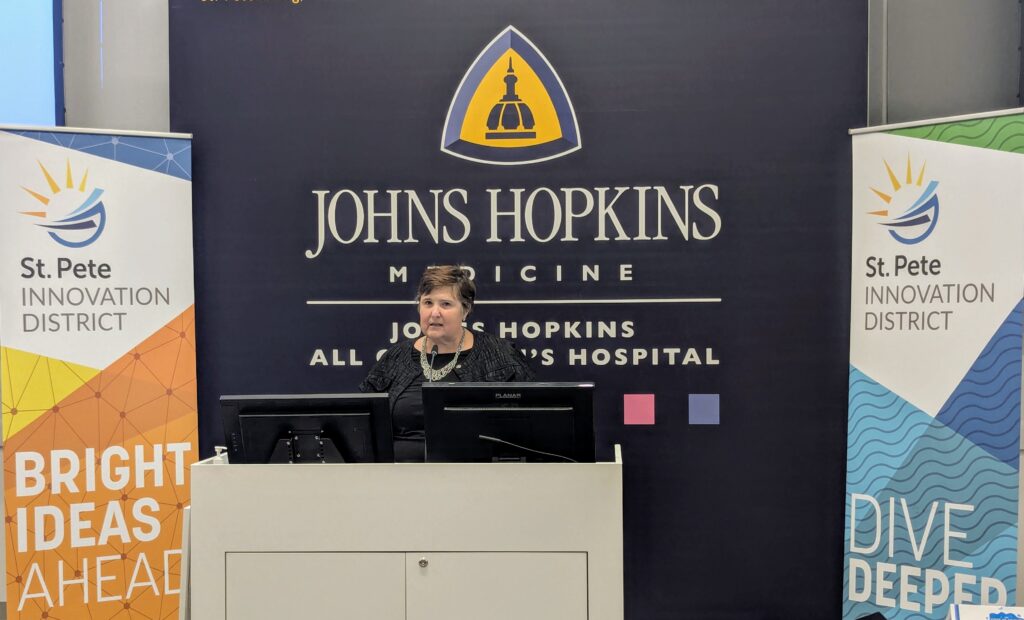St. Petersburg’s Innovation District encompasses less than 1% of the city’s square footage, yet accounts for over 7% of all jobs. The .88-square-mile area’s property value is $1.38 billion.
District stakeholders now plan to build on early success and identify untapped potential. For example, Port St. Petersburg remains vastly underutilized.
A long-awaited master plan, the district’s first since it launched in 2016, is nearing completion. An evaluation committee selected Kimley-Horn, a civil engineering, planning and design firm with extensive local experience, to lead those efforts in July 2023.
Jared Schnieder, transportation and urban planning associate at Kimley-Horn, hopes to complete a draft by late April or early May. The master plan will address smart mobility solutions, sustainable development and expanding the Maritime and Defense Technology Hub.
“Activating the (Albert Whitted) Airport and Port (St. Pete) area has just started to come up,” said Alison Barlow, the district’s executive director. “And there’s been fun conversations about the air taxi idea and what it would look like if we wanted to get more involved with maritime taxis.”

An overhead view of the Innovation District, with Albert Whitted Airport to the right. Screengrab.
The district boasts over 50 collaborative public and private organizations, including “anchors” like the University of South Florida St. Petersburg, the College of Marine Science, Johns Hopkins All Children’s Hospital and the St. Petersburg Downtown Partnership. Community engagement is a critical aspect of the extensive master planning process.
Barlow has recently led a “flurry” of storm-delayed public outreach events. Schneider listed a “few of the more innovative ideas we are hearing and thinking about.” Those include:
- Smart mobility solutions: Improved district mobility could include micro-transit, water taxis, electronic vertical takeoff and landing vehicles (eVTOLs), autonomous vehicles and multimodal connections to downtown and surrounding neighborhoods.
Barlow said focus groups questioned eVTOL safety and placement but were intrigued by the potential. “I didn’t hear anybody who was actively against it.”
Barlow admitted she never considered water taxis ferrying people around the St. Petersburg peninsula. “It seems very logical,” she said.
- Green infrastructure and sustainability: Schneider said retaining and redirecting water in a “more holistic manner” is a priority in the low-lying district. Stakeholders would also like to implement new storm surge and flood protection technologies.
- Greenspace improvements: Schneider said those could include smart lighting and wayfinding opportunities, public art integration and “additional linkages to and celebration of the waterfront.”
- Collaboration: Schneider said stakeholders hope to build upon the “great work Alison (Barlow) is already doing” and increase collaborative opportunities through shared workspaces and labs, funding and additional event coordination.
- Smart Development and Buildings: Focus groups want to share parking and create energy-efficient building systems with controlled lighting and air conditioning. “Parking has come up a number of times as a need in multiple places in the district,” Barlow said.

Alison Barlow, executive director of the St. Petersburg Innovation District. Photo by Mark Parker.
Barlow and district partners also hope to bolster the blue economy, which encompasses myriad industries, by unifying various groups whose “world touches the water.” The overarching goal is to discern local needs and opportunities.
Those conversations began in 2024 when the district, Tampa Bay Wave and the College of Marine Science applied for and won a $14.9 million National Oceanic and Atmospheric Administration grant. While supporting startups was the initial focus, Barlow stressed the importance of including “our traditional St. Pete ocean team.”
“It’s a critical economic driver, and it even does touch hospitality,” she added. “It is so much a part of our lifeblood … and we don’t talk about it as a single ecosystem very often.”
City officials began taking a long-overdue look at the Port St. Pete’s trajectory in January 2023. The city-owned facility’s master plan will dovetail with the surrounding district’s initiative.
Barlow said city and district officials continue exploring avenues to build a second Maritime and Defense Technology Hub at the site. She noted it could encompass 50,000 square feet, and stakeholders are exploring available public funding and potential private investments.
American Cruise Lines now offers eight-day trips to Key West from the port, which also houses the Cross Bay Ferry, for approximately $7,000. Barlow said the city has “really started to drive more activity.”
Scheider said Kimley-Horn continues scheduling master plan workshops with community stakeholders. The firm hopes to host an event celebrating its launch in the late spring.
To learn more about the master plan and submit ideas, visit the website here.
The post Planning for Innovation District’s future nears completion appeared first on St Pete Catalyst.
